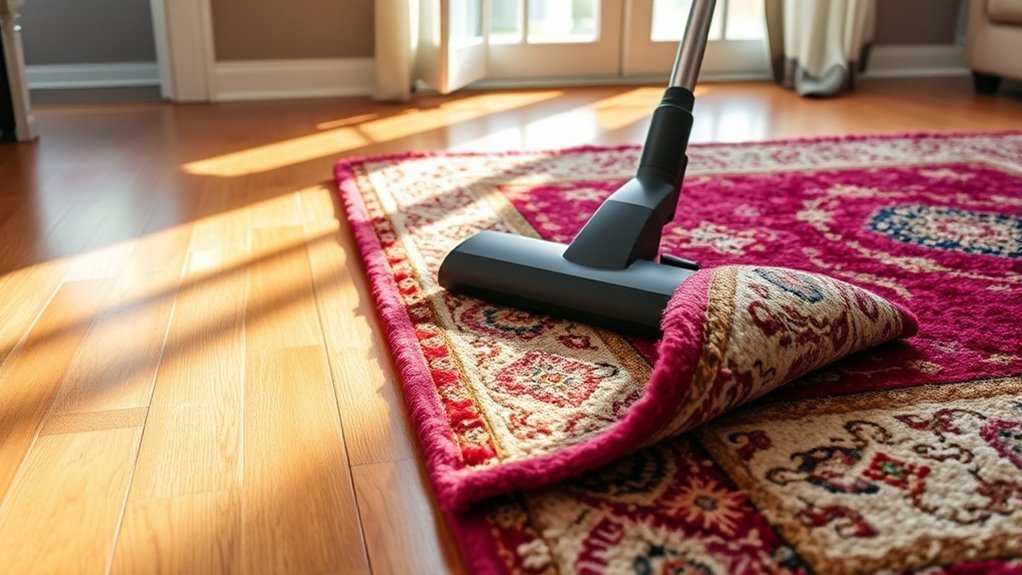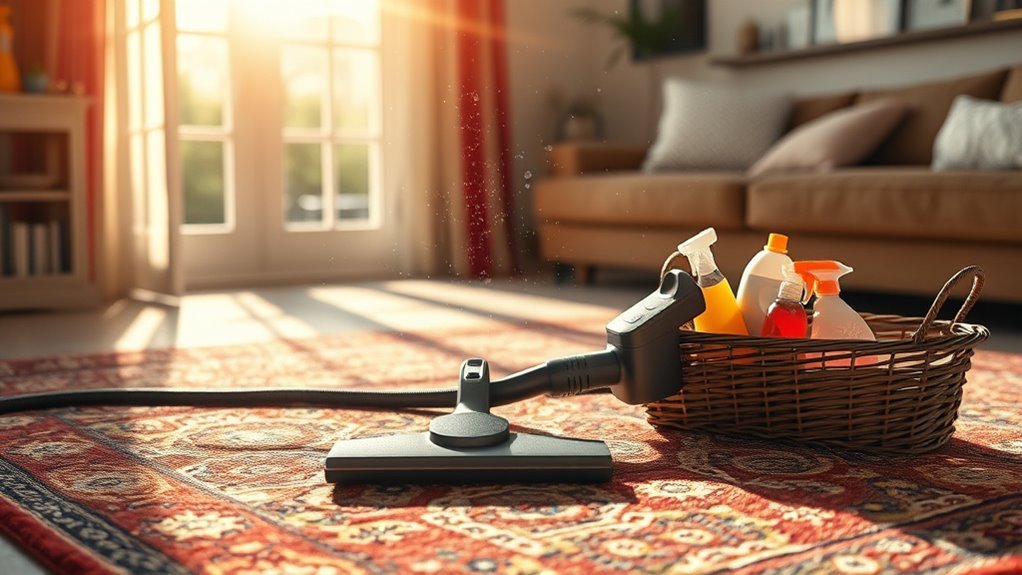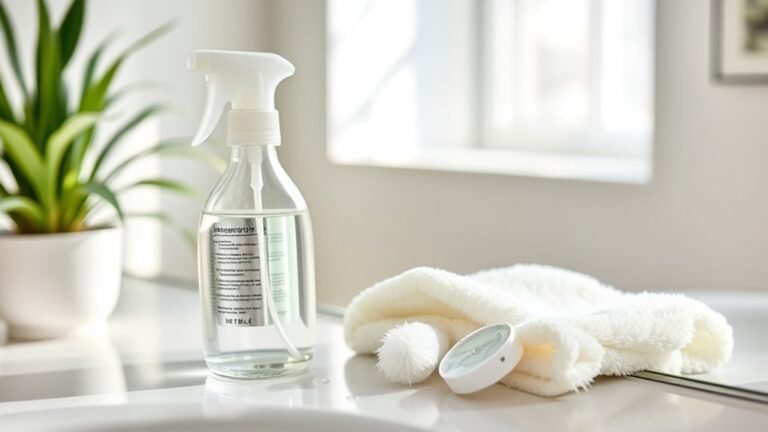Weekly Cleaning Routine for Rug
For a weekly rug cleaning routine, start by vacuuming both sides to remove dirt and dust. Shake or beat the rug outside for extra debris removal. Check for stains and spot clean them promptly using a gentle, tested solution to avoid damage. Rotate the rug to guarantee even wear, and regularly air it out in a dry, sunny spot to prevent odors and mildew. Don’t forget to inspect and maintain the rug padding for added comfort and longevity. There’s more to maintaining a pristine rug beyond these steps.
Gather Essential Cleaning Supplies

Before you begin cleaning your rugs, you’ll need to gather all the essential supplies to guarantee an efficient and effective routine. First, identify your rug materials—whether wool, cotton, synthetic, or silk—since cleaning techniques vary accordingly. You’ll need a vacuum cleaner with adjustable suction to avoid damage, a soft-bristle brush for delicate fibers, and a microfiber cloth for spot cleaning. Select a gentle, pH-neutral detergent appropriate for your rug type to prevent fading or fiber weakening. A spray bottle will help you apply cleaning solutions evenly, while a bucket of lukewarm water assists rinsing. Finally, have a drying rack or an airy space ready to let your rugs dry thoroughly without mold risk. Being methodical in gathering these tools sets the stage for a freeing, hassle-free cleaning experience.
Remove Loose Dirt and Debris
Start by thoroughly vacuuming your rug to lift loose dirt and dust from its fibers. Next, take the rug outside and give it a firm shake to dislodge any remaining debris trapped deep inside. For stubborn particles, gently beat the rug with a broom or rug beater to guarantee all dirt is removed before proceeding.
Use a Vacuum Cleaner
Although it might seem straightforward, using a vacuum cleaner properly is crucial to effectively remove loose dirt and debris from your rugs. Start by selecting the right vacuum attachment; a brush tool works best for delicate fibers, while a beater bar suits sturdier rugs. Use slow, overlapping strokes to guarantee thorough cleaning without damaging the pile. Adjust your vacuum techniques based on rug type—short, quick passes for flatweaves, longer, slower moves for plush rugs. Don’t forget to vacuum both sides if possible. Regularly empty the vacuum canister or replace bags to maintain suction power. By mastering these vacuum techniques and utilizing appropriate vacuum attachments, you’ll extend your rug’s lifespan and keep it looking fresh, giving you more freedom to enjoy your space without worrying about hidden dirt.
Shake and Beat Rug
Vacuuming removes a significant amount of dirt, but some particles remain embedded deep within the rug fibers. To tackle this, take your rug outside and employ effective shake techniques. Begin by grasping the rug firmly at both ends, then shake it vigorously to dislodge dust and debris trapped inside. For stubborn dirt, gently beat the rug using a carpet beater or a sturdy stick; this rhythmic impact loosens particles that vacuuming misses. Make sure you work methodically, covering the entire surface evenly to maintain consistent rug maintenance. Afterward, inspect the rug for any remaining dirt and repeat if necessary. These steps not only refresh your rug but also extend its lifespan, giving you the freedom to enjoy a cleaner, healthier living space.
Vacuum Thoroughly on Both Sides

One essential step in maintaining your rug’s appearance is to vacuum both its surface and underside thoroughly. Start by vacuuming the top side slowly, using a setting suited for your rug’s material. This removes dust, dirt, and debris embedded in the fibers. Then, carefully flip the rug over and vacuum the back to dislodge any hidden particles and dust mites. This dual approach is a key rug maintenance technique that prevents buildup, prolonging your rug’s life. Be methodical: vacuum in multiple directions to reach all fibers evenly. Consistent application of this cleaning technique guarantees your rug stays fresh and vibrant, giving you the freedom to enjoy a clean, inviting space without hassle or damage over time.
Address Stains Promptly
When a stain appears, first identify its type to choose the right cleaning solution. Always apply the cleaner carefully, then blot the area gently instead of rubbing to avoid spreading or damaging fibers. Prompt action and correct technique are key to preventing permanent marks on your rug.
Identify Stain Type
How quickly you respond to a stain on your rug can make all the difference in preventing permanent damage. To act effectively, you need to master stain identification techniques. Recognizing common stain types allows you to tailor your response methodically. Here’s how to identify stains:
- Observe Color and Texture: Note if the stain is oily, sticky, or powdery.
- Smell Carefully: Some stains, like food or pet accidents, have distinct odors.
- Test Solubility: Gently dab with water to see if the stain dissolves or spreads.
- Consider Source: Think about what caused the stain—wine, coffee, ink, or dirt.
Use Appropriate Cleaners
Although quick action is essential, selecting the right cleaner based on the stain type guarantees effective removal without damaging your rug. You’ll want to choose eco friendly cleaners for delicate fibers or when reducing chemical exposure matters. For stubborn stains, commercial products designed specifically for rugs offer potent solutions but use them cautiously.
| Stain Type | Recommended Cleaner | Notes |
|---|---|---|
| Organic (food, drink) | Eco friendly enzyme cleaner | Breaks down proteins gently |
| Oil-based | Commercial degreaser | Targets grease effectively |
| Ink or dye | Alcohol-based cleaner | Test on hidden area first |
Blot, Don’t Rub
Act quickly to address stains by blotting the affected area with a clean, white cloth or paper towel. Blotting techniques are essential for effective stain prevention, as rubbing can push stains deeper into rug fibers. Follow these steps to maintain your rug’s freedom from permanent marks:
- Gently press the cloth onto the stain to absorb liquid without spreading it.
- Use a fresh section of the cloth repeatedly to avoid reapplying the stain.
- Avoid scrubbing; instead, lift the stain by blotting from the outside inward.
- Once the stain is mostly absorbed, apply a suitable cleaner cautiously and blot again.
This method guarantees contaminants don’t embed further, preserving your rug’s texture and appearance while granting you freedom from stubborn stains.
Spot Clean With Appropriate Solutions
A small spill on your rug calls for immediate attention with the right cleaning solution to prevent stains from setting. First, identify the rug’s material to select stain removal solutions that won’t cause damage. Use spot cleaning techniques by applying a small amount of cleaner directly onto the spill, then gently blot with a clean cloth. Avoid oversaturating the area; excess moisture can weaken fibers and cause discoloration. For organic stains, a mild detergent mixed with water works well, while tougher stains might require specialized products. Always test your chosen solution on an inconspicuous spot before full application. By following these precise steps, you maintain your rug’s appearance and extend its lifespan, giving you the freedom to enjoy a spotless, vibrant space.
Rotate the Rug for Even Wear

Since foot traffic and sunlight exposure vary across different parts of a room, rotating your rug regularly helps distribute wear evenly. This simple step is essential among rug longevity tips, ensuring your rug maintains its appearance and durability over time. To apply even wear techniques effectively, follow these steps:
Rotating your rug regularly balances wear from foot traffic and sunlight, preserving its look and durability.
- Mark your rug’s current position with tape for consistency.
- Rotate the rug 180 degrees weekly to balance foot traffic impact.
- If possible, flip the rug to expose less worn areas.
- Adjust placement to avoid prolonged exposure to direct sunlight.
Air Out Your Rug Regularly
While regular vacuuming removes surface dirt, airing out your rug is essential for eliminating trapped moisture and odors that can degrade fibers over time. To do this effectively, take your rug outside on a dry, sunny day. Lay it flat or hang it over a sturdy railing to guarantee both sides get exposure to fresh air. Avoid damp or humid conditions, as these can encourage mold growth. Aim to air your rug weekly or at least biweekly as part of your rug maintenance routine. This practice not only refreshes the fibers but also prolongs the rug’s lifespan by preventing mildew and musty smells. Incorporating fresh air into your cleaning regimen gives you control over your environment, promoting freedom from indoor pollutants and maintaining a vibrant, healthy rug.
Check and Maintain Rug Padding
Beyond airing out your rug to keep it fresh, paying attention to the rug padding beneath can greatly impact its durability and comfort. Proper padding maintenance guarantees your rug stays in place, cushions foot traffic, and extends its lifespan. Here’s how you can methodically care for your rug padding:
Proper rug padding care enhances comfort, prevents slipping, and prolongs your rug’s life.
- Inspect Weekly: Lift the rug to check for wear, moisture, or debris trapped in the padding.
- Clean Gently: Vacuum the padding occasionally to remove dust without causing damage.
- Replace When Needed: Don’t hesitate to swap out padding that’s compressed or deteriorated to maintain proper support.
- Confirm Proper Fit: Confirm the padding matches the rug size to prevent slipping and uneven wear.
Schedule Deep Cleaning Periodically
Although regular vacuuming keeps your rug looking tidy, scheduling deep cleaning periodically is essential to remove embedded dirt, allergens, and stains that routine care can’t reach. Aim to establish a deep cleaning frequency that matches your lifestyle and rug usage—typically every 12 to 18 months works well. Use seasonal cleaning tips to guide you; spring and fall are ideal for thorough cleanings, helping refresh your space and prepare for changing weather. When planning, consider professional services for delicate or large rugs to guarantee proper treatment. Mark your calendar and stick to the schedule without fail. This methodical approach guarantees your rug remains vibrant and allergen-free, giving you the freedom to enjoy a clean, healthy home without constant worry or effort.
Frequently Asked Questions
Can I Use a Steam Cleaner on All Types of Rugs?
You can’t use a steam cleaner on all rugs because steam cleaner compatibility depends heavily on the rug material. Delicate fibers like silk or wool might get damaged by high heat or moisture, so you need to check the rug’s care label first. Synthetic rugs usually handle steam cleaning better. Always consider rug material considerations carefully to avoid shrinking, color bleeding, or weakening fibers—this way, you keep your rug fresh without risking damage.
How Do I Prevent Color Fading in My Rug?
Did you know that up to 30% of a rug’s color can fade within the first year without proper care? To guarantee effective color protection and fading prevention, position your rug away from direct sunlight and use UV-blocking window treatments. Regularly rotate the rug to distribute wear evenly, and clean it gently with color-safe products. These steps help you maintain vibrant hues, giving you the freedom to enjoy your rug’s beauty longer.
Are There Natural Alternatives to Chemical Cleaning Solutions?
You can definitely choose natural alternatives to chemical cleaning solutions for your rug. A vinegar solution works well; just mix equal parts white vinegar and water, then gently blot stains. Baking soda is another excellent option—it deodorizes and lifts dirt. Sprinkle it on, let it sit for 15-20 minutes, then vacuum thoroughly. These methods are safe, effective, and give you the freedom to clean without harsh chemicals, preserving your rug’s color and texture.
How Often Should I Replace My Rug Padding?
When it comes to rug padding, you don’t want to wait until the cows come home to think about replacement frequency. Typically, you should replace your rug padding every 5 to 10 years, depending on wear and tear. If it feels compressed or has lost its cushioning, it’s time for an upgrade. Regularly checking guarantees your rug stays comfortable and extends its lifespan, giving you the freedom to enjoy your space worry-free.
Can Pets Damage the Rug Fibers Beyond Cleaning?
Yes, pets can damage rug fibers beyond cleaning, especially if their behavior includes scratching, chewing, or frequent accidents. These actions can weaken or stain fibers, making routine rug maintenance essential. You’ll want to regularly vacuum, promptly address stains, and consider protective treatments. Understanding your pet’s habits helps you prevent long-term damage, preserving your rug’s appearance and extending its life, giving you the freedom to enjoy your space worry-free.






